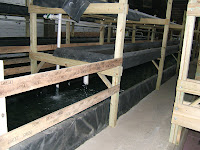As part of traveling that narrow road, one of our biggest challenges is balancing how much food we donate vs. how much we sell to stay sustainable. As a start up business, you are looking to capture every penny to become established and keep your head above water. Our case is similar as a start-up nonprofit, though we also rely on donations - at least for now, to help bridge the gap.
Another challenge we have is educating our community. The food industry and false advertising has nearly ruined the relationship the customer has with the farmer. I would think a high percentage of Americans don't even know a farmer. Many folks today are more worried about the quality of gas they put in their car than they are the quality of food they put in their bodies. Cheap, when it comes to food, equals problems. We've experienced this first hand.
This boiled egg is ready for dinner. Notice the dark orange yolk. You can't buy this at the grocery store.
As farmers, we know that we will never be able to sell a dozen eggs for .99 or a pound of tomatoes for $1.50. Quality in equals quality out. We pay close attention to what we feed our livestock (Certified non GMO feed without pesticides or herbicides), what we feed our vegetables (organic fertilizers and foliar spray) and more importantly - what we don't. We, as all farmers, hate weeds in the garden - but we don't spray them with poison, we pull them.
One of our focuses is producing large amounts of high quality food on small footprints. This could then be replicated in other communities by developing modular based systems that can be dropped in depending on the size of the property. How do you do it?
- Having a soil building plan, via making compost in large quantities or sourcing it out. Using compost in the soil at higher rates will give the soil a higher capacity to support more plants.
- Running livestock in mob style paddocks (at rates that don't exceed the soils capacity), will fertilize the land with heavy doses of manure and add much needed organic matter as it breaks down. This will allow for more animals on less land if managed correctly.
- Developing systems like aquaponics that allow for the growth of high quality fish and plants in a one input system. This will allow, depending on the size of the tanks, the production of large quantities of fish in smaller areas.
- Maximizing greenhouse space by going vertical. A "Growing Power" type approach.
Growing Power's aquaponics system on the left and Sweetwater's system on the right. Both are capable of producing several tons of fish a year.
To create a successful system, dividing the tank into three or four "paddocks" will allow for a continued harvest of fish throughout the year. This produces a high protein food and helps to sustain a year round income stream.
Another system related to this is pondaponics. This is the same as aquaponics, but instead uses an existing lake or pond to pump into a hydroponics type set-up. The fertilizer (sludge) pumped from the bottom of the pond would act in the same manner to provide plants with a sustainable source of nutrition.
All this and more is part of our growing plan to become sustainable and support a non-profit, community based farm. As we continue to grow, the priority will always be the same - educating, becoming and staying sustainable and giving to those in need. Simple, right?




thank you for the info this has been really helpful, my wife and i are trying to do the same and i hope to be up and running by this time next year :)
ReplyDeletei wish you the best of luck and keep up the good work!
Thanks Cory!
DeleteIts always good to learn tips like you share for blog posting. As I just started posting comments for blog and facing problem of lots of rejections. I think your suggestion would be helpful for me. I will let you know if its work for me too.
ReplyDeleteThanks! for this lovely piece of information about aquaponics.I found this information useful.
ReplyDeletefind best pictures of aquaponics systems and aquaponics types in details.
ReplyDelete